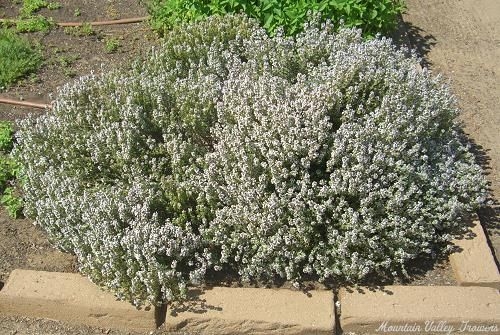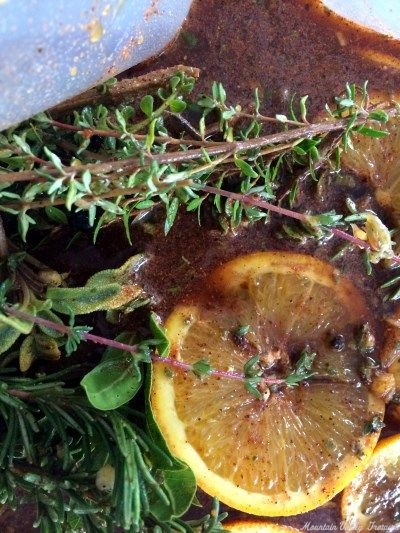Growing & using English Thyme

A humble little plant from the Western Mediterranean, Thyme is one of those plants that has so many different common names it can make your head swim. Fortunately, it has only one Latin name, Thymus vulgaris. The myriad of names for this simple culinary plant can be more than a little confusing. After all recipes don’t call for a pinch of ‘German Winter Thyme’ or a spot of ‘French Summer Thyme’; they just call for Thyme.
Why so many names for basically the same plant? A single batch of Thyme seed can produce a lot of minutely different looking thymes with minutely different amounts of flavor. Thus, from Thymus vulgaris seed, we have, not only the two mentioned above, but also ‘Narrow Leaved French’, ‘Greek Gray’ and ‘Broad Leaf English’ and what we call English Thyme. Really a more appropriate name for all these slightly different thymes would be Garden Thyme, or even Common Thyme. After all the word vulgaris means (no, not vulgar) common.
Every once in a while, a really different form of Thymus vulgaris emerges, like Silver Thyme. This is a slightly variegated Common Thyme with the same flavor but a different look. Unlike some variegated plants, this plant is not a sport but a mutated seedling that does not revert back to green. Hi Ho Silver Thyme, a recently introduced variegated Common Thyme, also remains variegated throughout its life. This variety has greater white splotching on its leaves which gives it a more luminescent look. Both of these can be substituted for Common Thyme in any recipe. Hi Ho Silver makes an attractive garnish for your gourmet presentations.
There are also Thymus vulgaris seedlings that have slightly different flavors. Thank goodness they have been given distinctive enough names, like Orange Balsam Thyme and Italian Oregano Thyme to easily identify them from the regular common thymes.
Using these varieties in recipes calling for Thyme adds a bit of intrigue to the dish because these have slightly different chemical make-ups when compared to Common Thyme.
Culinary Thymes bloom in early spring and attract early butterflies and many different kinds of beneficial flies and wasps. They are also a favorite of honey bees. They should be planted in full sun for best flavor. The ground should be well drained and fairly fertile. After they have bloomed, we will pull them up in a ponytail and crop them past the spent blooms (about a third of the way into the leaves).
The leaves can be used fresh any time; but for drying, it is best to cut fresh growth after the bloom cycle. When three or four inch pieces of new growth can be harvested, cut these in the early morning, after the dew has dried, and make small bundles. Hang these out of direct light and check often for dryness. How long this will take depends on the moisture in the air. It is very important to make sure the Thyme is completely dry before storing, because improperly dried herbs can mildew and rot. If the herb is crispy when crushed between the fingers, then it is dry. When using dried herbs, always remove the herbs from the jar away from the steam of what you are cooking to avoid introducing moisture into the jar.
Thyme leaves may be small, but they pack a powerful punch. Thyme is one of the savory herbs, which are main course herbs used to flavor hardy meals, bone warming soups, and piquant sauces. It is also one of the three traditional herbs used in Fines Herbes. Thyme blends well with other savory herbs like French Tarragon and Winter Savory to create some memorable flavors.

This citrus and English Thyme barbeque marinade used for smoking turkey. marinade is your basic brine (salt, water, apple cider vinegar) full of orange slices and a savory barbeque sauce plus lots of fresh herbs including English Thyme, Rosemary, Greek Oregano, Greek Bay and Sweet Myrtle. To really infuse flavor, we let the turkey marinate for three days before smoking.

English Thyme is one of the six plants chosen to be in our Kitchen Herb Garden Six Pack. It also makes a great addition to our Small Space Herb Garden Six Pack.
This plant is often available in plug trays. These trays hold 128 of all the same plant. They are a great low cost way to fill a lot of space. Each cell is 3/4 of inch by an inch. Check here to see if English Thyme Plug Trays are available.



